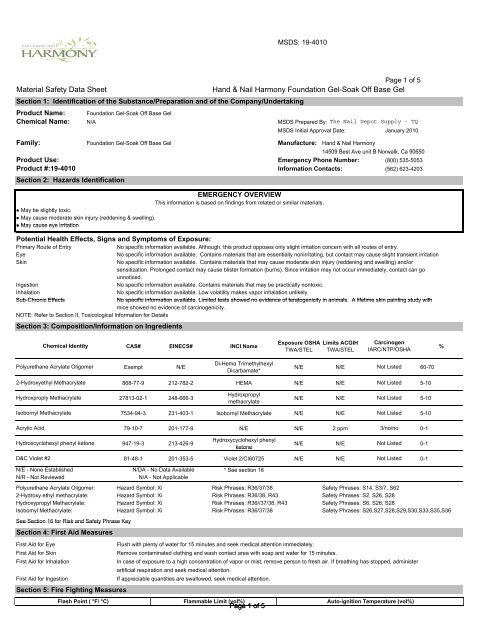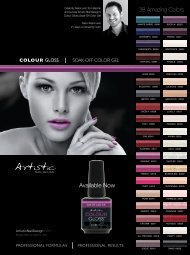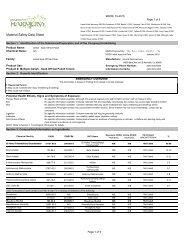Harmony-Gelish Foundation - The Nail Depot Supply
Harmony-Gelish Foundation - The Nail Depot Supply
Harmony-Gelish Foundation - The Nail Depot Supply
You also want an ePaper? Increase the reach of your titles
YUMPU automatically turns print PDFs into web optimized ePapers that Google loves.
MSDS: 19-4010<br />
Material Safety Data Sheet<br />
Page 1 of 5<br />
Hand & <strong>Nail</strong> <strong>Harmony</strong> <strong>Foundation</strong> Gel-Soak Off Base Gel<br />
Section 1: Identification of the Substance/Preparation and of the Company/Undertaking<br />
Product Name: <strong>Foundation</strong> Gel-Soak Off Base Gel<br />
Chemical Name: N/A MSDS Prepared By:<br />
MSDS Initial Approval Date: January 2010<br />
Family: <strong>Foundation</strong> Gel-Soak Off Base Gel Manufacture: Hand & <strong>Nail</strong> <strong>Harmony</strong><br />
14509 Best Ave unit B Norwalk, Ca 90650<br />
Product Use: Emergency Phone Number: (800) 535-5053<br />
Product #:19-4010 Information Contacts: (562) 623-4203<br />
Section 2: Hazards Identification<br />
EMERGENCY OVERVIEW<br />
This information is based on findings from related or similar materials.<br />
● May be slightly toxic.<br />
● May cause moderate skin injury (reddening & swelling).<br />
● May cause eye irritation<br />
Potential Health Effects, Signs and Symptoms of Exposure:<br />
Primary Route of Entry<br />
No specific information available. Although, this product opposes only slight irritation concern with all routes of entry.<br />
Eye<br />
No specific information available. Contains materials that are essentially nonirritating, but contact may cause slight transient irritation<br />
Skin<br />
No specific information available. Contains materials that may cause moderate skin injury (reddening and swelling) and/or<br />
sensitization. Prolonged contact may cause blister formation (burns). Since irritation may not occur immediately, contact can go<br />
unnoticed.<br />
Ingestion<br />
No specific information available. Contains materials that may be practically nontoxic.<br />
Inhalation<br />
No specific information available. Low volatility makes vapor inhalation unlikely.<br />
Sub-Chronic Effects<br />
No specific information available. Limited tests showed no evidence of teratogenicity in animals. A lifetime skin painting study with<br />
mice showed no evidence of carcinogenicity.<br />
NOTE: Refer to Section II, Toxicological Information for Details<br />
Section 3: Composition/Information on Ingredients<br />
Chemical Identity<br />
CAS# EINECS# INCI Name<br />
Exposure OSHA<br />
TWA/STEL<br />
Limits ACGIH<br />
TWA/STEL<br />
Carcinogen<br />
IARC/NTP/OSHA<br />
%<br />
Polyurethane Acrylate Oligomer<br />
Exempt<br />
N/E<br />
Di-Hema Trimethylhexyl<br />
Dicarbamate*<br />
N/E N/E Not Listed 60-70<br />
2-Hydroxyethyl Methacrylate<br />
868-77-9 212-782-2 HEMA N/E N/E Not Listed 5-10<br />
Hydroxproply Methacrylate<br />
27813-02-1 248-666-3<br />
Hydroxpropyl<br />
methacrylate<br />
N/E N/E Not Listed 5-10<br />
Isobornyl Methacrylate<br />
Acrylic Acid<br />
7534-94-3 231-403-1 Isobornyl Methacrylate N/E N/E Not Listed 5-10<br />
79-10-7 201-177-9 N/E N/E 2 ppm 3/no/no 0-1<br />
Hydroxcyclohexyl phenyl ketone<br />
947-19-3 213-426-9<br />
Hydroxycyclohexyl phenyl<br />
ketone<br />
N/E N/E Not Listed 0-1<br />
D&C Violet #2<br />
N/E - None Established<br />
N/R - Not Reviewed<br />
Polyurethane Acrylate Oligomer:<br />
2-Hydroxy ethyl methacrylate:<br />
Hydroxypropyl Methacrylate:<br />
Isobomyl Methacrylate:<br />
See Section 16 for Risk and Safety Phrase Key<br />
Section 4: First Aid Measures<br />
81-48-1 201-353-5 Violet 2/CI60725 N/E N/E Not Listed 0-1<br />
N/DA - No Data Available<br />
* See section 16<br />
N/A - Not Applicable<br />
Hazard Symbol: Xi<br />
Risk Phrases: R36/37/38<br />
Safety Phrases: S14, S3/7, S62<br />
Hazard Symbol: Xi<br />
Risk Phrases: R36/38, R43<br />
Safety Phrases: S2, S26, S28<br />
Hazard Symbol: Xi<br />
Risk Phrases: R36//37/38, R43<br />
Safety Phrases: S6, S26, S28<br />
Hazard Symbol: Xi<br />
Risk Phrases: R36/37/38<br />
Safety Phrases: S26,S27,S28,S29,S30,S33,S35,S36<br />
First Aid for Eye<br />
Flush with plenty of water for 15 minutes and seek medical attention immediately.<br />
First Aid for Skin<br />
Remove contaminated clothing and wash contact area with soap and water for 15 minutes.<br />
First Aid for Inhalation<br />
In case of exposure to a high concentration of vapor or mist, remove person to fresh air. If breathing has stopped, administer<br />
artificial respiration and seek medical attention.<br />
First Aid for Ingestion<br />
If appreciable quantities are swallowed, seek medical attention.<br />
Section 5: Fire Fighting Measures<br />
Flash Point ( °F/ °C)<br />
Flammable Limit (vol%)<br />
Page 1 of 5<br />
Auto-ignition Temperature (vol%)
212 °F/100 °C Seta flash<br />
No Data<br />
No Data<br />
Method:<br />
Extinguishing Media:<br />
Fire Fighting Instructions:<br />
Use carbon dioxide or dry chemical for small fires; aqueous foam or water for large fires.<br />
Remove all ignition sources. Wear self-contained breathing apparatus and complete personal protective equipment when entering<br />
confined areas where potential for exposure to vapors or products of combustion exists.<br />
Unusual Hazards:<br />
High temperatures and fire conditions may cause rapid and uncontrolled polymerization which can result in explosions and the<br />
violent rupture of storage vessels or containers. Avoid the use of a stream of water to control fires since frothing can occur.<br />
Section 6: Accidental Release Measures<br />
Spill or Release Producers:<br />
Spontaneous polymerization can occur. Eliminate ignition sources. Use eye and skin protection. Place leaking containers in a well<br />
ventilated area. Dike and recover large spills. Soak up small spills with inert solids (such as vermiculite, clay) and sweep/shovel<br />
into disposal container. Wash spill area with strong detregent and water solution; rinse with water, but minimize water use during<br />
clean-up. Do not flush to sewer! US Regulations (CERCLA) require reporting spills and releases to soil, water and air in excess of<br />
reportable quantities. <strong>The</strong> toll free number for the US Coast Guard National Response Center is (800) 424-8802. EU Regulations<br />
require the consultation of Directive 98/24/EC. Dispose and report per regulatory requirements if necessary. Please prevent<br />
washings from entering waterways.<br />
Section 7: Handling and Storage<br />
Handling:<br />
Avoid contact with skin and eyes. Avoid breathing vapor. Keep container closed when not in use. Avoid prolonged exposure to<br />
light. Remove all contaminated clothing, shoes, belts and other leather goods immediately. Incinerate leather goods (including<br />
shoes). Wash contaminated clothing thoroughly before reuse. Wash skin thoroughly with soap and water after handling. Solvents<br />
should not be used to clean skin because of increased penetration potential.<br />
Most acrylic monomers have low viscosities, thus only needing room temperature conditions to facilitate proper pouring techniques.<br />
However, viscous type gels such as these may require heating to facilitate proper pouring techniques. To ensure that this happens<br />
product may be heated to 60°C/140°F for not more than 24 hours. Do NOT use localized heat sources such as band heaters to<br />
heat/melt product. Do NOT use steam. Hot boxes or hot rooms are recommended for heating/melting material. <strong>The</strong> hot box and/or<br />
room should only be set to a maximum temperature of 60°C/140F. Do not overheat, this may compromise product effectiveness<br />
and should be avoided. Refrain from multiple reheating of product, this will also diminishing the quality of the product.<br />
Storage:<br />
Product is extremely light sensitive. If exposed to natural light, LED, UVA, UVB or UV any light, material will cure very quickly.<br />
Store in a cool, dry place, away from heat and all types of light. Store at temperatures below 100°F/38°C but above<br />
the product's freezing point. If no freezing point is given, keep above 32°F/0°C at all times.<br />
Explosion Hazard:<br />
High temperatures and fire conditions may cause rapid and uncontrolled polymerization which can result in explosions and the<br />
violent rupture of storage vessels or containers.<br />
Section 8: Exposure Controls / Personal Protection<br />
Engineering Controls<br />
Personal Protective Equipment<br />
General:<br />
Local exhaust recommended to control exposure which may result from operations generating aerosols and hot operations<br />
generating vapors.<br />
To identify additional Personal protective Equipment (PPE) requirements, it is recommended that a hazard assessment in accordance<br />
with the OSHA PPE Standard (29CFR1910.132), or European Standard EN166 be conducted before using this product. Provide eye<br />
wash stations and safety showers. Wear impervious clothing to prevent ANY contact with this product, such as gloves, apron<br />
boots, or whole body suits. Nitrile rubber is better than PVC.<br />
Eye / Face Protection:<br />
Wear chemical splash goggles<br />
Skin Protection:<br />
Wear impervious gloves (Neoprene)<br />
Respiratory Protection:<br />
A NIOSH/MSHA approved air purifying respirator with an organic vapor cartridge or canister may be permissible under certain<br />
limited circumstances where airborne concentrations are expected to exceed exposure limits. Protection provided by nuisance<br />
level organic vapor dust masks can be used, however the use of the respirator is limited. Follow OSHA respirator regulations<br />
found in 29 CFR 1910.134134 or European Standard EN 149.<br />
Section 9: Physical and Chemical Properties<br />
Appearance<br />
Odor & Odor Threshold<br />
pH<br />
Specific Gravity<br />
Viscosity<br />
%Volatile<br />
Clear to slight violet, viscous liquid<br />
characteristic acrylate odor<br />
NA (H20=1): 1.15<br />
N/DA By Volume:
Fumes produced when heated to<br />
May occur --- Uncontrolled polymerization may cause rapid evolution of heat and increased pressure that could<br />
decomposition may include:<br />
result in violent rupture of sealed storage vessels or containers.<br />
carbon monoxide, carbon dioxide<br />
Conditions to Avoid:<br />
Storage100 °C<br />
Section 15: Regulatory Information<br />
US Federal Regulations<br />
Clean Air Act: HAP/ODS<br />
Clean Water Act: Priority Pollutant<br />
FDA: Food Packaging Status<br />
Occupational Safety and Health Act<br />
Irritation - Eye<br />
No info available<br />
Toxicity to Sewage Bacteria<br />
This product contains the following hazardous air pollutants (HAP), as defined by the U.S. Clean Air Act:<br />
● Acrylic Acid CAS# 79-10-7(HAP)<br />
This product contains no ODS's<br />
This product contains no chemicals listed under the U.S. Clean Water Act Priority Pollutant List<br />
This product has not been cleared by the FDA for use in food packaging and / or other applications as an indirect<br />
food additive.<br />
This product is considered to be a hazardous chemical under the OSHA Hazard Communication Standard. Its hazard<br />
are:<br />
● Immediate (acute) health hazard<br />
● Delayed (chronic) health hazard<br />
● Reactive hazard<br />
RCRA This product is not considered to be a hazardous waste under RCRA (40 CFR 261)<br />
SARA Title III: Section 302 (TPQ)<br />
This product contains the following chemicals regulated under Sec. 302 as extremely hazardous substance that<br />
carry a TPQ.<br />
● NONE<br />
SARA Title III: Section 304<br />
This product contains the following chemicals regulated under Section 304 as extremely hazardous chemical for<br />
N/DA
SARA Title III: Section 311-312:<br />
SARA Title III: Section 313:<br />
TSCA Section 8(b) Inventory:<br />
TSCA Significant New Use Rule:<br />
● Acrylic Acid CAS #79-10-7 RG (LBS) 5000<br />
This product is considered hazardous under the OSHA Hazard Communication Standard and is regulated under<br />
Section 311-312 (40 CFR 370). Its hazards are:<br />
● Immediate (acute) health hazard<br />
● Delayed (chronic) health hazard<br />
● Reactive hazard<br />
This product contains the following chemicals subject to the reporting requirements of Section 313 of Title III of the<br />
Superfund Amendments and Reauthorization Act of 1986 and 40 CFR Part 372:<br />
Acrylic Acid CAS #79-10-7<br />
This product contains chemicals listed on the TSCA inventory or otherwise complies with TSCA premanufacture<br />
notification requirements.<br />
None of the chemicals listed have a SNUR under TSCA.<br />
State Regulations<br />
CA Right-to-Know Law: Acrylic Acid CAS #79-10-7<br />
California No Significant Risk Rule:<br />
NONE<br />
MA Right-to-Know Law: Acrylic Acid CAS #79-10-7<br />
NJ Right-to-Know Law: Acrylic Acid CAS #79-10-7<br />
PA Right-to-Know Law: Acrylic Acid CAS #79-10-7<br />
FL Right-to-Know Law: Acrylic Acid CAS #79-10-7<br />
MN Right-to-Know Law:<br />
NONE<br />
International Regulations<br />
CDSL: Canadian Inventory<br />
(on Canadian Transitional List)<br />
Labeling according to EC Directives - 1999/45/EC<br />
European Community:<br />
Hydroxpropyl methacrylate CAS #27813-02-1 is on the DSL List. WHMIS = D2B<br />
Hyroxycyclohexyl phenyl ketone CAS# 947-19-3 is on the DSL list. WHMIS - n/da<br />
2-Hydroxyethyl methacrylate CASE# 868-77-9 is on the DSL List. WHMIS - n/da<br />
Isobornyl Methacrylate CAS# 7534-94-3 is on the DSL list. WHMIS - n/da<br />
Acrylic Acid CAS #79-10-7 is on the DSL list. WHMIS - B2, E, DIA, F<br />
HNH Base Gel:<br />
● HAZARD SYMBOLS: Xi irritant<br />
● RISK PHRASES: R22: Harmful if swallowed, R36/38: Irritating to eyes and skin R43: May cause sensitization by<br />
skin contact.<br />
t<br />
● SAFETY PHRASES: S18: Handle and open container with care, S24/25: avoid contact with skin and eyes, S36/37:<br />
Wear suitable protective clothing and gloves, S38: in case of insufficient ventilation, wear suitable respiratory<br />
equipment.<br />
Section 16: Other Information<br />
EU Classes and Risk / Safety Phrases for Referenced Ingredients (See Section 2):<br />
Hazard Symbols:<br />
Xi - Irritants<br />
Risk Phrases:<br />
R36/37/38 Irritating to eyes, respiratory system and skin; R43 May cause sensitization by skin contact<br />
Safety Phrases:<br />
S2 Keep out of reach of children; S3/7 Keep container tightly closed in a cool place; S26 In case of contact with eyes, rinse immediately with plenty of water and seek<br />
medical advice; S27 Take off immediately all contaminated clothing; S28 After contact with skin, wash immediately with plenty of water; S29 Do not empty into drains;<br />
S30 Never add water to this product; S33 Take precautionary measures against static discharges; S35 This material and its container must be disposed of in a safe way;<br />
S36 Wear suitable protective clothing; S62 If swallowed, do not induce vomiting; seek medical advice immediately and s how this container or label; 36/37 Wear suitable<br />
protective clothing and gloves; S62 If swallowed, do not induce vomiting; seek medical advice immediately and show the container or label.<br />
Hazard Rating System (Pictograms)<br />
NFPA:<br />
Flammability (1)<br />
HMIS:<br />
Health (2) Reactivity (1)<br />
This information presented herein was obtained from sources considered to be reliable. However, this information is provided without any warranty, expressed or<br />
implied, regarding its correctness or suitability for consumers intended use and/or application. For this and other reasons, we assume no responsibility and expressly<br />
disclaim liability for loss, damage or expense arising out of any way connected with the handling, storage use or disposal of the product. This MSDS was prepared<br />
expressly for this product. Use the materials only as directed. If the product is used as a Page component 4 of of 5<br />
another product, the information contained within the MSDS
may not be applicable. If there are any problems or concerns understanding this MSDS form, please direct all questions to INFOTRAC, Chemical Emergency Resources<br />
System at (1-800-535-5053).<br />
Page 5 of 5





